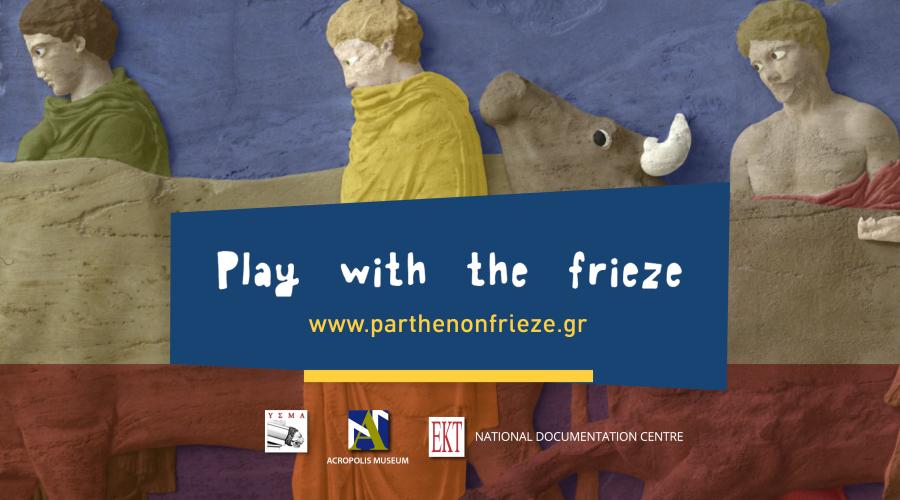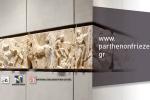
Two digital games, the result of a collaboration between the Acropolis Museum and the Information and Education Department of the Acropolis Restoration Service (YSMA) and the National Documentation Centre (EKT), invite young and old alike to discover the Parthenon frieze in a creative way. The games ‘The colours of the frieze’ and ‘god, man, animal’ are available to the Greek and international public at https://parthenonfrieze.gr/en/games/
‘The colours of the frieze’: Children become ancient painters
Did you know that the current almost white hue of the Parthenon frieze is due to time? The frieze was painted with wonderful colours. Red, blue, green, yellow and gold were some of the colours used by ancient artists. In order to complete the temple, its sculptures had to be coloured.
With the game ‘The colours of the frieze’ you can become ancient painters. Choose the colours you want from the palette at the bottom of the screen and choose among three blocks (representations of: Oxen and guides, Water Jar Carriers, Gods) the area you want to colour. In this way the frieze comes alive with the colours you have chosen, while at the same time you have information about the block you are colouring.

‘God, man, animal’: Interactive memory game
Did you know that the Parthenon frieze had 115 blocks, a total length of 160 metres, depicted 378 human and divine figures and more than 200 animals? The game ‘god, man, animal’ helps you to get to know the variety of figures depicted in the frieze. They are brought to life by the artists who create the impression of motion.
Through digital memory cards, you sharpen your mind by choosing the degree of difficulty. While at first glance the figures look very similar, there are details that make them stand out, such as their posture, facial expressions, head movement, details on their clothes and weapons, and the ceremonial vessels they hold. Mortals and gods, athletes and horsemen, lords and priests, men, women and children, horses and animals, are depicted in perfect harmony!

Educational material for home and school!
At the same time, both games are accompanied by printable materials for home and classroom use. Indicatively, in the game ‘The colours of the frieze’ all the pages can be printed so that the blocks can be decorated with a collage of coloured paper or other available materials. All the pieces can then be joined together to the actual size of the block.
In the game ‘god, man, animal’ children can print and cut out all the cards to form 16 pairs with figures from the frieze, which they can then stick on thick cardboard and play the game alone or with their friends and classmates. In class, children can be divided into groups and play a unique board game, with each group participating with their pawn in the Panathenaic procession to honour the goddess Athena. The interactive digital games for the Parthenon frieze are available in Greek and English.

The Parthenon frieze and the web application parthenonfrieze.gr
The Parthenon frieze, a continuous band of reliefs surrounding the upper part of the temple wall, depicts the procession to the Acropolis during the Great Panathenaea, the festival in honour of the goddess Athena. The composition of the procession included 378 human figures, men and women, pedestrians, horsemen and charioteers, and more than 200 animals and objects and gifts to Athena, the patroness of Athens. The Parthenon frieze, 160 metres long and almost 1 metre high, was designed by the sculptor Phidias.
The frieze consisted of 115 blocks of various sizes, with continuous relief representations of people and animals. The work as a whole is divided into four sections: The preparation of the procession, the main procession with the lining up of the horsemen and chariots, the procession of offerings and animals for sacrifice, and the main worship with the delivery of the veil to the goddess.
Of the entire frieze, 50 metres are preserved today in the Acropolis Museum and 80 metres in the British Museum. One block is found in the Louvre Museum and some fragments are scattered among various European museums. The web application parthenonfrieze.gr collects and annotates, in Greek and English, photographic material of all the surviving blocks of the frieze. At the same time, in order to give the fullest possible picture of this miraculous ensemble, the photographic material of the blocks is supplemented with the surviving drawings of J. Carrey (1674) and J. Stuart (1751).
EKT developed the parthenonfrieze.gr web application, in collaboration with the Acropolis Museum and YSMA, utilising photographic material and the many years of documentary activity of the scientific staff of the two institutions, and applying all the latest technologies for its virtual representation and optimal promotion on the internet. The application incorporates all the latest accessibility features, following best practice of responsive web design and user-centric UI / UX. Practically, this means one can access it from all smart, desktop and mobile devices and reach the same level of detail in an adaptable user-friendly interface.
A long-term partnership with significant results and multifaceted benefits
Over the last twenty years, YSMA, the Acropolis Museum and EKT have charted a parallel digital course in the cultural and educational events of the country, making a series of cutting-edge digital content infrastructures available to the public through their multifaceted collaborative actions.
The collaboration of the three institutions began in 2003 when the virtual representation of the Parthenon frieze was released for the first time on CD-ROM. In 2009, a standalone website with rich texts and educational applications for the frieze was developed with Flash technologies.
In 2010, the creation and availability of the Parthenon Frieze Repository (http://repository.parthenonfrieze.gr), which functioned complementary to the corresponding website was completed, while two years later the repository of educational content for the Acropolis (http://repository.acropolis-education.gr) hosting material of the Information and Education Department of the YSMA was delivered to the educational community of the country.
In 2016, EKT developed the YSMA repository (http://repository-ysma.ekt.gr) which collects archival material from the restoration projects of the Acropolis of Athens and the open catalogue of the YSMA library (https://ysma.openabekt.gr) was posted in the digital public space through the openABEKT digital cloud infrastructure. In the same year, 4,108 items of YSMA were collected in the national digital cultural content aggregator Searchculture.gr. A few years later, all YSMA items were semantically enriched and made available, through EKT, to the European digital library Europeana.
In 2022, YSMA, the Acropolis Museum (bodies of the Ministry of Culture) and EKT (body of the Ministry of Digital Governance) collaborated again in order to make an advanced web application for the Parthenon frieze and the virtual representation of the famous marble blocks of the temple available to the interested public. The content of the application is being gradually enriched with new digital collections, such as interactive digital games.








